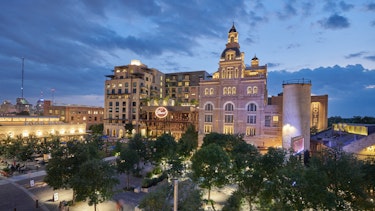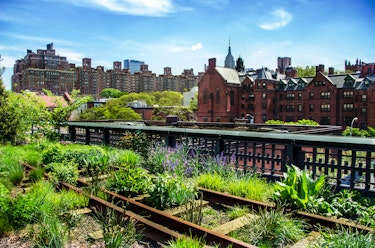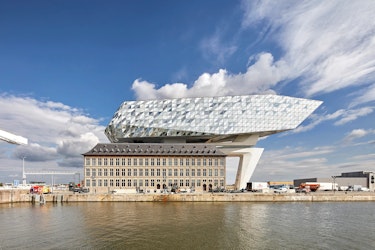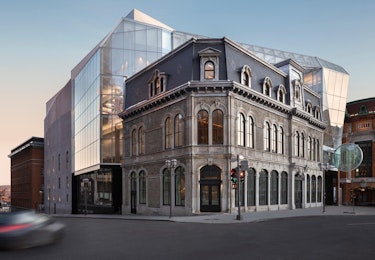The preservation of existing structures stands at the intersection of history, culture, and sustainability. These structures are not just architectural artifacts; they are repositories of historical narratives and cultural identities. Yet, the relentless march of urbanization and shifting needs often places them on the brink of demolition. The demolition of these structures not only severs our connection to the past but also contributes to waste and energy consumption. In response to these challenges, innovative methods are emerging to save buildings from demolition and unveil their untapped potential for adaptive reuse and transformation. This essay explores the significance of preserving existing structures, the challenges that come with it, and the innovative procedures that unlock their potential.

Credit: Architectural Review
The Importance of Preserving Existing Structures
Historical and Cultural Significance
Existing structures are more than just bricks and mortar; they are living testaments to history and culture. They tell the stories of bygone eras and reflect the architectural styles and societal values of their times. Preserving them means preserving our history. The historical context that these structures offer is invaluable. They provide insights into the technological, social, and economic aspects of different periods. Furthermore, the preservation of existing structures contributes to the cultural identity of a place. The architecture and design of these structures often embody the unique character of a region or community, making them an integral part of the local culture.
Sustainable Development
Preserving existing structures is inherently sustainable. It conserves the resources embedded in their construction, from energy-intensive materials to embodied carbon. It is an eco-conscious approach that aligns with the principles of a circular economy, where the reuse and adaptation of existing resources are prioritized. Moreover, the process of preserving existing structures typically results in a lower carbon footprint compared to new construction. By retrofitting and reusing buildings, we can significantly reduce the environmental impact associated with new construction, which often entails resource extraction, manufacturing, and transportation.
Economic Viability
The economic aspect of preservation cannot be understated. Adaptive reuse and renovation of existing structures can often be more cost-effective than demolishing and constructing entirely new buildings. This is particularly true when dealing with historically or architecturally significant structures that are expensive to replicate. Moreover, the revitalization of areas through the preservation of existing structures can stimulate economic activity. Repurposing these structures can breathe new life into declining neighborhoods or districts, attracting businesses, residents, and tourists.

Credit: San Antonio Report
Challenges in Preserving Existing Structures
Obsolescence and Neglect
One of the most common challenges in preserving existing structures is their obsolescence. Many buildings become functionally obsolete due to changes in technology, industry, or the needs of the community. The structure that once served its purpose effectively may no longer be suited to contemporary demands. Neglect is another significant challenge. When existing structures are left to deteriorate due to a lack of maintenance, their restoration and reuse become more complex and costly. Neglect accelerates the degradation of building materials and systems, requiring extensive rehabilitation efforts.
Regulatory and Zoning Hurdles
Preservation efforts can be hampered by regulatory and zoning constraints. Existing zoning codes may not permit the adaptive reuse of structures for certain purposes, creating legal and bureaucratic obstacles. Preservation regulations may require significant compliance efforts, including rigorous approval processes, assessments, and documentation. Property owners may find it financially burdensome to navigate these regulatory hurdles, discouraging preservation efforts.
Structural and Environmental Issues
The physical condition of existing structures can present challenges to their preservation. The structural integrity of a building may be compromised due to aging, lack of maintenance, or alterations made over the years. Addressing structural issues can be a complex and costly undertaking. Additionally, some existing structures may have environmental contamination, such as asbestos, lead paint, or soil contamination. Remediation efforts are necessary to ensure the safety of occupants and comply with environmental regulations. These issues further add to the complexities of preserving existing structures.

Credit: The High Line
Innovative Procedures for Preserving Existing Structures
Building Information Modeling (BIM)
Building Information Modeling (BIM) technology is revolutionizing the way architects and engineers approach the preservation of existing structures. BIM allows for the creation of accurate 3D models of existing buildings, capturing their geometry, structure, and systems. This digital representation provides a comprehensive understanding of the building, facilitating the identification of structural issues and the planning of renovations. BIM is also employed to perform energy analysis, assessing the energy performance of an existing building and identifying areas where energy-efficient retrofits can be implemented. By utilizing BIM, professionals can make informed decisions that optimize the preservation process.
Adaptive Reuse
Adaptive reuse is a creative and sustainable approach to preserving existing structures. It involves repurposing a building for a different function while preserving its original character and significant features. Adaptive reuse allows buildings to evolve and serve new purposes while maintaining their historical and architectural value. This approach requires innovative design thinking, as architects and designers must find ways to adapt old structures for new uses, sometimes in ways that were never envisioned when the building was originally constructed.
Sustainable Retrofits
Sustainable retrofits focus on enhancing the environmental performance of existing structures through the integration of green building technologies and principles. This approach allows for the improvement of energy efficiency and the reduction of a building's carbon footprint. Sustainable retrofits often involve the installation of energy-efficient HVAC systems, the use of high-performance insulation materials, and the implementation of green roofs and solar panels. Passive design principles, such as natural ventilation and daylighting, are also employed to reduce energy consumption. By incorporating these sustainable elements, existing structures can be brought up to modern standards of energy efficiency and environmental responsibility.
Deconstruction and Salvage
Deconstruction and salvage represent an eco-conscious approach to dismantling and repurposing existing structures. Rather than demolishing a building and sending its components to a landfill, deconstruction involves carefully disassembling the structure with the intent of salvaging materials for reuse. This process significantly reduces waste and preserves valuable building materials. Salvaged materials, such as bricks, timber, windows, and doors, can be repurposed in other construction projects, including the restoration of the same or similar structures. By salvaging and reusing these materials, the heritage and character of a building can be maintained, even if the original structure no longer stands.

Credit: Architizer
The Future of Preserving Existing Structures
Preservation as a Priority
Changing attitudes and a growing appreciation for history, culture, and sustainability are making preservation a priority in urban planning and architecture. Preservation is no longer seen as an impediment to progress but as a means to create vibrant and culturally rich urban environments. Cities and communities are recognizing that their existing structures are valuable assets that contribute to the quality of life for residents and visitors.
Adaptive Legislation
Governments at various levels are enacting legislation to encourage and facilitate the preservation of existing structures. These laws recognize the importance of heritage conservation and provide incentives and protections for property owners who wish to preserve their buildings. Adaptive legislation can include zoning changes that allow for a wider range of uses within historic structures and tax incentives for rehabilitation.
Technological Advancements
Advancements in construction and building technology are making the preservation of existing structures more efficient and cost-effective. Modern construction methods, materials, and tools allow for more precise and less invasive rehabilitation processes. Innovations in building materials, such as sustainable and energy-efficient products, support preservation efforts and enhance the sustainability of retrofitted structures.
Public Engagement
Engaging the community in preservation efforts is a key aspect of the future of preserving existing structures. When the public is involved in decisions about the future of historic or culturally significant buildings, there is a stronger sense of ownership and shared responsibility. Community involvement can lead to more sustainable and culturally sensitive preservation efforts. Furthermore, public awareness campaigns can foster a deeper appreciation for the cultural and historical significance of existing structures.
Cultural Awareness
Promoting cultural awareness and education is essential for the long-term preservation of existing structures. Public programs and initiatives that teach the importance of cultural heritage and architectural history can have a lasting impact. Cultural awareness can lead to a sense of responsibility for preserving the built environment, encouraging individuals to take an active role in the protection of their community's architectural heritage.

Credit: Azure Magazine
The preservation of existing structures is not just an architectural pursuit; it is an act of cultural and environmental stewardship. These structures are more than the sum of their materials; they are the keepers of history and the embodiment of culture. Preserving them ensures that the stories of the past continue to resonate in the present and shape the future. Innovative procedures and a growing awareness of their importance are giving new life to the idea of preserving what we have, rather than replacing it. In doing so, we honor the history of our communities, lessen our impact on the environment, and enrich our cities with the stories of the past. As we look ahead, unlocking the potential of existing structures will remain an integral part of building a more sustainable, culturally vibrant, and resilient world.
